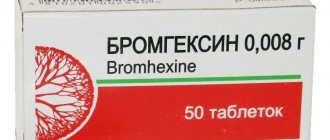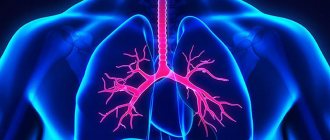The main groups of drugs that are used to treat cough:
- Drugs that improve sputum discharge: expectorants,
- mucolytics.
- central action,
The choice of medication should be individual for everyone. Before you start taking the drug, be sure to consult your doctor.
Expectorants
This group of drugs stimulates the secretion of bronchial glands and the movement of the epithelium, increases the volume of sputum and slightly reduces its viscosity.
Direct action
Resorptive (direct) action drugs directly affect bronchial secretion. They are used in the form of tablets, solutions and mixtures.
- potassium iodide, sodium iodide, sodium bicarbonate, ammonium chloride.
Reflex action
Reflex (indirect) action drugs irritate the stomach receptors, causing a reflex increase in gland secretion and stimulating muscle contraction when coughing. Used in the form of infusions, powder, tablets, dry extract, collections, etc.
- thermopsis herb (Codesan), terpinhydrate (Coldrex), licorice root (Doctor MOM), marshmallow (Mukaltin), guaifenesin (Tussin), ammonia-anise drops and others.
Herbal remedies
Essential oils of medicinal plants have expectorant, anti-inflammatory and weak antiseptic effects.
- thyme herb (Bronchicum), eucalyptus leaf (Pectussin), ivy leaves (Gedelix), licorice (Glyceram), oregano, coltsfoot, elecampane and other plants in various combinations.
A prerequisite for the development of the therapeutic effect of any expectorant medications is regular drinking of water to prevent dehydration.
Side effects and contraindications
The use of some drugs is limited in pediatrics, pregnancy and lactation, carbohydrate metabolism disorders, as well as in the acute period of certain diseases. A complete list of contraindications and restrictions is indicated in the instructions for the drug.
- Stomach. When taken orally, they irritate the gastrointestinal mucosa and increase the secretion of gastric juice, therefore they are not used for gastritis and peptic ulcers.
- Allergy. Plant extracts often cause allergic reactions and are contraindicated in bronchial asthma.
- Vomit. Reflex-action drugs strengthen not only the cough reflex, but also the gag reflex. Large doses cause nausea and vomiting. Young children, as well as those with central nervous system damage, should not use them, as respiratory arrest may occur.
- For children. Medicines from these groups significantly increase the volume of secretions. But small children are not able to fully expectorate sputum themselves. This can lead to congestion in the bronchi and re-spread of infection.
pharmachologic effect
Most expectorants of plant or synthetic origin act by a reflex mechanism. They reflexively enhance the secretion of water and bicarbonates by the goblet cells of the bronchi. In this case, sputum, absorbing water, loses its viscosity, becomes more fluid, is easier to exfoliate and is evacuated both by the cough reflex and by the ciliated epithelium of the bronchi.
A separate group of mucolytic agents is distinguished (from the Latin mucus mucus and lysis decay). This is a group of synthetic substances that have an expectorant effect according to a special mechanism. Unlike expectorants, they directly interact with sputum and cause the breakdown of the viscous gel-like matrix at the chemical level by breaking the disulfide bonds of the mucopolysaccharide. This leads to liquefaction of sputum and easier removal. This type of pharmacological action is called mucolytic.
Mucolytics
Modern drugs, which are mainly prescribed for infectious and inflammatory diseases of the respiratory system, combine mucoregulatory and mucolytic properties, and also have a secretomotor effect.
- Mucolytics change the physicochemical properties and structure of bronchial mucus, causing it to liquefy and facilitate the removal of sputum.
- Mucoregulators change the ratio of liquid and dense parts of sputum, stimulate the synthesis of lysozyme by the epithelium and the formation of surfactant in the lungs.
Proteolytic enzymes
These drugs break down protein and polypeptide molecules. They are capable of thinning even thick purulent sputum, acting in affected tissues without affecting healthy ones. Such drugs are often administered by inhalation, intratracheal and intrabronchial routes.
- trypsin, chymotrypsin, ribonuclease, dornase alpha.
Synthetic drugs
The drugs bromhexine, ambroxol (Ambrobene, Lazolvan), acetylcysteine (ACC, Fluimucil), carbocysteine and their analogues combine several properties and are widely used by specialists. Such drugs are optimal for the treatment of respiratory diseases and cough, especially in children. On the pharmaceutical market there is a large selection of release forms for different ages: syrups, solutions and drops, tablets and dragees.
Side effects of mucolytics
- Taking mucolytics can provoke allergic reactions, pulmonary hemorrhages, bronchospasm, and impair liver and kidney function.
- Use is limited to children under 3 years of age, pregnant and nursing mothers, and persons with liver and kidney diseases.
- Mucolytics, like expectorants, are undesirable to prescribe to bedridden patients due to the accumulation of liquid secretions and the effect of “flooding” the lungs.
- The clinical effect when taking expectorants and mucolytics is observed, as a rule, after 4-8 days. Before this, there may be an “imaginary deterioration” of the condition.
Antitussives
Central action
narcotic drugs suppress the cough reflex in the medulla oblongata and depress the respiratory center. They are addictive.
- codeine (Codelac), morphine, ethylmorphine hydrochloride, dextromethorphan (Grippex).
Non-narcotic - have an antitussive and antispasmodic effect, without depressing breathing and without causing addiction.
- butimirate (Intussin, Sinekod), glaucine (Broncholitin, Glauvent), oxeladine (Tusuprex, Paxeladin).
Peripheral action
They act as mild analgesics on the receptors of the respiratory mucosa and reduce the cough reflex. One of the most important effects of medications in this group is hydration of the mucous membranes. They are used in the form of aerosols and steam inhalations to reduce the viscosity of secretions and against irritation of the mucous membrane.
Local anesthetics are used mainly in hospitals to stop the cough reflex during bronchoscopy.
- benzocaine, tetracaine, lidocaine, prenoxdiazine (Libexin).
Enveloping preparations of plant origin are used for irritation of the mucous membrane of the upper respiratory tract. They create a protective layer for the mucous membrane of the nasopharynx and oropharynx, which reduces the cough reflex.
- extracts of eucalyptus, acacia, wild cherry, various infusions, syrups, teas, lozenges, lozenges, honey.
Inhalation of water vapor with the addition of various components (sodium chloride, sodium bicarbonate, ammonium chloride, plant extracts) is the most common way to moisturize the mucous membranes.
Introduction
Hypersecretion of mucus into the lumen of the respiratory tract is a characteristic feature of a number of pulmonary diseases, such as acute and chronic bronchitis (CB), chronic obstructive pulmonary disease (COPD), cystic fibrosis (CF), bronchiectasis and bronchial asthma (BA).
Regular cough with sputum production (productive cough) together with impaired mucus drainage are significant in the clinical assessment of the severity of pulmonary disease and an argument for the prescription of mucolytic and mucoactive drugs. The main effect of mucolytic drugs is their effect on the viscosity of secretions, the volume and nature of mobilization of sputum from large and small bronchi [1]. The modern classification of mucoactive drugs is simple and based on their main action. It is customary to distinguish expectorants (expectorants), mucolytics, mucokinetics and mucoregulators. Expectorants enhance the secretion of mucins and increase their hydration (guaifenesin, hypertonic solution). Mucolytics (N-acetylcysteine, carbocysteine, dornase alpha) significantly reduce the viscosity of mucus. Mucokinetics actively change the movement of the cilium, increase the mobilization of secretions and “ease” cough (ambroxol, β2-adrenergic agonists, surfactant) [2].
We paid special attention to a prominent representative of the group of mucokinetics - vasicinoid or “ambroxol” - the only eighth metabolite of bromhexine, which has a pronounced stimulating effect on mucociliary clearance (MCC). This interest in ambroxol is associated with a progressively increasing number of randomized clinical studies showing its high effectiveness in respiratory diseases with hypersecretion of secretions (COPD) [3], exacerbations of chronic disease [4–8], in patients with CF [9, 10], during therapy newborns with hyaline membrane disease (respiratory distress syndrome of newborns) [11, 12], in patients with asthma [13], with antioxidant therapy [14], to prevent bronchopulmonary complications after thoracic interventions [15], in acute diseases of the upper respiratory tract [ 16], with pulmonary alveolar proteinosis [17]. Experimental studies on animals are exploring the possibility of using ambroxol to reduce fibrosis of lung tissue [18].
Chemical formula and primary pharmacology of ambroxol
Ambroxol hydrochloride (C13H18Br2N20) is a benzylamine derivative, the active N-desmethyl metabolite of bromhexine hydrochloride (2-amino-3,5-dibromo-N-methylbenzylamine hydrochloride), which is a synthetic derivative of vasicin, a substance obtained by extraction from the herb Adhatoda vasica (Adatoda vascularis), a plant known in medicine for several centuries, which has anti-inflammatory, analgesic, expectorant, diuretic, anti-asthmatic and abortifacient effects, is an antiseptic and insecticide, has a sedative and antispasmodic effect.
The mechanism of action of ambroxol has been thoroughly investigated in numerous pharmacological and clinical studies. It consists of a mucokinetic effect [19], mucociliary activity [19], stimulation of surfactant production [20, 21], anti-inflammatory and antioxidant effects [22], as well as local analgesic (anesthetic) properties [23, 24].
Mucokinetic action and mucociliary activity
In animal studies (anesthetized rabbits and guinea pigs), ambroxol hydrochloride significantly increased bronchial secretion in a dose-dependent manner (dose-dependent effect) [25–27]. The best way to deliver ambroxol is the inhalation route to ensure direct intratracheal action.
In animal studies of isolated bronchopulmonary preparations (rats, hamsters, cats), ambroxol stimulated ciliary activity [28]. It should be noted that a significant increase in the frequency of ciliary contractions was found in cells of the isolated trachea of guinea pigs [19]. In an in situ study on frog esophagus preparations, a dose-dependent significant effect of enhancing mucus transport was shown with topical application of ambroxol [29]. It has been established that high mucociliary activity is inherent in ambroxol, especially with its topical intrabronchial administration.
Stimulation of the surfactant system
The special properties of ambroxol are associated with the activation of the surfactant system of the lungs. Surfactant has been shown to have the property of blocking the adhesion of mucus to the walls of the bronchial tree, which facilitates mucus transport [29]. Ambroxol stimulates the production of surfactant by type II pneumocytes (alveolocytes) [30]. Regulation of surfactant levels may be a major mechanism of protection against influenza A virus infection [31]. Rats treated with ambroxol at doses of 100 and 200 mg/kg orally for 3 and 6 days showed a sharp volumetric increase in type II alveolocytes in the lungs with a significant increase in the percentage of lamellar bodies to the total area of alveolar tissue [32]. Treatment of rats with ambroxol (200 mg/kg/day orally) was accompanied by an increase in the incorporation of 3H-palmitic acid into alveolar tissue, which leads to increased synthesis of pulmonary surfactant [33–35]. Surfactant stimulation with ambroxol has been shown in studies in premature and newborn animals. Treatment of pregnant rabbits with ambroxol (50 mg/kg intravenously) on days 24–26 of pregnancy led to an improvement in the pulmonary function of prematurely delivered premature fetuses [36–37]. Administration of ambroxol (4 mg/kg/day) to pregnant animals on days 21–24 of gestation caused a significant improvement in the maturation of lung tissue in 25-day-old preterm rabbits [38]. Moreover, the effect of ambroxol on adult animals (“minipigs” - small pigs) with acute respiratory distress syndrome caused by aspiration of hydrochloric acid was noted. Treatment with ambroxol led to the survival of all treated animals, while animals in the control group died within 12 hours [39].
Antioxidant and anti-inflammatory activity
The antioxidant properties of ambroxol are associated with the absorption of free radicals [40–44]. Research convincingly shows that ambroxol protects the bronchopulmonary apparatus from oxidative stress and free radicals generated by inhalation of tobacco smoke, toxic substances, activation of neutrophils and alveolar macrophages [45–46].
The anti-inflammatory properties of ambroxol have been proven in studies of the inflammatory effects of neutrophils, macrophages and mast cells. Ambroxol is endowed with the ability to alter the oxidative and proteolytic histotoxic activity of neutrophils by interfering at different levels [47]. Ambroxol significantly reduces lipopolysaccharide (LPS)-induced cytokine synthesis in rat alveolar macrophages, as well as LPS-induced nitric oxide production [48, 49].
Ambroxol significantly reduces histamine levels and the release of growth factor from human mast cells and monocytes, which are found in large numbers in the lungs, skin and intestines. It has been established that ambroxol weakens bronchoconstriction and actively suppresses the release of histamine and the synthesis of leukotrienes [50–53].
The anti-inflammatory properties of ambroxol were studied in an acute model of lung injury, in which it reduced LPS-induced pulmonary hemorrhage, edema, exudation and neutrophil infiltration. When treated with ambroxol, the concentrations of protein, tumor necrosis factor α, interleukin-6 and transforming growth factor β1 in bronchoalveolar lavage significantly decreased [54–57]. During influenza viral infection in experiments on mice, ambroxol suppressed the reproduction (multiplication) of the virus in liquid media of the respiratory tract, which significantly increased the survival rate of animals infected with influenza A virus. Unfortunately, the nature of this mechanism of action of ambroxol is not entirely clear and requires further study [58].
Local anesthetic (anesthetic) effect
The local anesthetic effect of ambroxol was first described back in 1977, but the underlying molecular mechanism of this effect remained poorly understood for a long time. Currently, there is irrefutable evidence that ambroxol is a powerful inhibitor of the neuronal voltage-dependent sodium channel, which is associated with its local anesthetic effect [59]. As a result, ambroxol is able to suppress cough and pain component (sore throat) in acute respiratory infections of the respiratory tract.
Clinical pharmacokinetics and metabolism
There are a variety of dosage forms of ambroxol: intravenous and intramuscular solutions, syrups, granules, tablets, capsules, suppositories and slow-release oral forms. After intravenous administration of ambroxol, its total plasma clearance is 660 ml/min, while renal clearance (53 ml/min) does not exceed 8% [60]. The volumetric distribution of ambroxol is high (about 560 liters with more than 17-fold accumulation in the lungs compared to blood plasma), due to which its half-life is considered long (10 hours). The absolute bioavailability of ambroxol after oral administration is 79%, and the sustained dose-dependent effect remains in the range from 30 to 500 mg for tablet forms. Absorption (absorption) is fast: Tmax – 1.6 hours. Plasma protein binding is 90% [61]. Ambroxol is mainly excreted from the body through biotransformation, the first phase of which is represented by metabolites of 3,5-dibromanthranilic acid, the second by various glucuronides. Cytochrome P450 3A4 has been shown to be responsible for the oxidative metabolism of ambroxol. However, no significant drug interactions have been identified with the use of ambroxol [62].
Clinical evidence of the effectiveness of ambroxol
Analysis of clinical data on the use of mucoactive substances in the treatment of non-infectious human diseases faces a number of significant difficulties. First, the vast majority of studies were performed more than 40 years ago, when “good clinical practice” (GCP) guidelines were not generally accepted. Second, research into the mechanisms of pulmonary disease associated with cough and sputum production was in its infancy. There were often no consent documents on the diagnosis and treatment of chronic respiratory diseases, such as chronic disease, COPD, emphysema, and asthma [63].
Clinical evaluation of the effect of chronic sputum-producing cough on morbidity and mortality in patients with pulmonary diseases was studied in the mid-1990s. It was found that in patients with sputum hypersecretion, 54% of deaths were caused by lower respiratory tract infection (LRTI) versus 28% in patients without sputum hypersecretion. Chronic sputum hypersecretion has become recognized as a reliable predictor of death in patients with COPD and associated with LRTI (relative risk - 3.5), in contrast to similar deaths among patients without LRTI (relative risk - 0.9) [64].
This made it possible to change approaches to further research on mucoactive drugs. The primary endpoints of the clinical trials were: 1) the effect of the drug on mortality; 2) the effect of the drug on exacerbations of the disease; 3) the effect of the drug on health and quality of life. From the database of clinical studies of ambroxol, we selected studies that complied with GCP requirements and were applicable for the correct assessment of the clinical effectiveness of treatments for acute and chronic respiratory diseases in adults.
Effects of treatment with ambroxol in adults
We divided all studies into short-term (<4 weeks) and long-term (>4 weeks). Given the requirement for randomization, blinding, placebo, or active control, only 3 of 24 short-term and 7 of 12 long-term studies were included in the analysis. Despite the positive results, the remaining studies were not considered due to poor design (open-label, uncontrolled, small number of patients, unspecified single doses).
Short-term studies of ambroxol (<4 weeks). Endpoints of short studies of ambroxol include only respiratory symptoms, mucus quantity/quality, cough productivity, bronchial flow parameters (forced expiratory volume in 1 second (FEV1), peak expiratory flow). All three studies indicate significant clinical efficacy of ambroxol in terms of improving respiratory symptoms, facilitating coughing, reducing mucus production [65], reducing sputum volume and viscosity [66], and reducing the number of patients who do not respond to therapy [67]. Spirometry was performed in all studies. Ambroxol had no effect on either FEV1 or PEF [65–67].
A study by Germouty and Jirou-Najou (1987) administered ambroxol along with an antibiotic and compared the effectiveness of the combination with placebo. It was found that ambroxol increased the concentration of the antibiotic in lung tissue and mucus. In a double-blind, placebo-controlled study, Fraschini et al. (1988) 60 patients with COPD with purulent sputum, divided into 3 groups, were prescribed amoxicillin, erythromycin or cefuroxime (all 1500 mg/day) together with ambroxol (90 mg/day) or placebo for 7 days. Antibiotic levels were measured in plasma and bronchial secretions on days 1 and 7 after 4 and 8 hours of drug administration. Compared with placebo, the combination with ambroxol significantly increased the level of the antibiotic in bronchial secretions (p<0.05), but not in plasma [68].
The short-term effects of ambroxol and some other mucolytics on pulmonary CBF in patients with COPD [69–74] are presented in the table.
In patients with COPD and severe MCB impairment, ambroxol significantly improved clearance, although overall changes remained moderate [73]. However, in studies examining the penetration index (i.e., the depth of distribution of labeled radioactive particles of a substance in the respiratory tract), ambroxol significantly increased it in each observation. The results obtained suggest that ambroxol helps reduce obstruction of small airways (bronchioles and bronchi) by increasing sputum clearance. This effect on the penetration index was also observed with bromhexine, in contrast to other mucolytics (guaifenesin, 2-mercaptoethane sulfonate, N-acetylcysteine), which never showed similar effects [71–74].
Long-term studies of ambroxol (>4 weeks). Five of the seven selected studies were randomized, double-blind, placebo-controlled [75–78]. In five of seven studies, the duration of ambroxol therapy exceeded 6 months, and the primary endpoints in 4 of them were the incidence of exacerbations of COPD and the number of days of disability [77]. Secondary endpoints of the study assessed sputum volume, physical status, symptoms of the disease (cough and sputum production), and respiratory function. The dose of ambroxol was 75 mg/day in studies longer than 6 months and 120 mg/day in two studies of shorter duration [78].
In the AMETHIST study (2004), the administration of high doses of ambroxol (120 mg/day) to patients with COPD who did not use inhaled glucocorticosteroids led to a decrease in the number of exacerbations, days of disability and the number of hospitalizations [7]. It has been noted that exacerbations of the disease (especially those requiring hospitalization) significantly increase the cost of treatment for patients with COPD [79].
It was found that ambroxol therapy did not change the parameters of external respiration function. Ambroxol had no effect on the symptoms of the disease, determined by the results of a questionnaire survey of the quality of life of patients with COPD. Despite the good study design (inclusion/exclusion criteria, statistical methods), the sample size of patients and the duration of follow-up did not fully meet the requirements for a full assessment of the QoL questionnaire. The weak effect of ambroxol on respiratory symptoms is explained by the short duration of mucolytic therapy, since most studies assessing the effects of long-acting bronchodilators and inhaled glucocorticosteroids on patients with COPD provide for a duration of therapy of at least a year [77–80].
Clinical safety of ambroxol
The drug form of ambroxol was introduced to the market in 1973. The safety of ambroxol in therapeutic use was analyzed in 15,000 patients in 100 studies assessing a total of 4,789,563 patient-years, as formally reported in the Periodic Safety Update Report. Rare reactions to the use of ambroxol include skin rashes, nausea and vomiting, abdominal pain, dyspepsia, and anaphylactic reactions. The incidence of adverse reactions did not exceed that for other mucoactive drugs.
In general, ambroxol can be regarded as a highly safe mucoactive substance, well tolerated by adults and children [81].
Modern doctrine of mucolytic therapy
During many years of medical practice, ambroxol was recognized as a substance with pronounced mucolytic, secretomotor effects, restoring the physiological mechanisms of clearing the airways, helping to prevent the “sticking” of viscous secretions, reducing airway resistance and enhancing bronchoalveolar aeration. Based on the therapeutic properties of ambroxol, its use is most rational in drug therapy regimens for patients with bronchopulmonary diseases and mucus hypersecretion. In this case, a separate group consists of patients who need to maintain “bronchial hygiene”.
The nebulizer method of drug delivery is preferable because it avoids side effects. The higher the concentration, the more pronounced the effects of ambroxol. It is recommended to initiate ambroxol therapy with the nebulizer delivery route, which has the following advantages: 1) wide dose variation; 2) local anesthetic effects (cessation of tickling and reduction of cough); 3) high topical concentration. Fine dispersion and high respirable fraction ensure the penetration of ambroxol into the distal sections of the bronchi, allowing for direct mucolytic, secretomotor, anti-inflammatory and antioxidant effects.
Ambroxol is advisable to use for anti-inflammatory and antioxidant therapy in patients with COPD. The effect of ambroxol to protect lung tissue begins at 2–3 weeks of therapy, and therefore a long-term regimen of long-acting forms of ambroxol at an average daily dose of 75–120 mg/day is recommended for a period of 1 to 12 months. The safety and effectiveness of this therapy were proven in the AME-THIST study [7].
Ambroxol therapy is indicated for acute lung injury (adult respiratory distress syndrome), when influencing the surfactant system is a priority. In such cases, both intravenous and inhalation delivery of the drug over a period of 6–8 months is advisable. Average daily therapeutic doses are recommended based on the patient's body weight.
There is a need for ambroxol therapy in patients with pneumonia. This strategy goes well with antibiotic therapy, as it helps to increase the accumulation of antibacterial agents in the affected lung. Obviously, the duration of such therapy should exceed one week. In such cases, it is advisable to expect the implementation of the antioxidant and anti-inflammatory effects of ambroxol. The use of this regimen for a month forms a stable “barrier protection” in people who have had pneumonia. There was a decrease in the frequency of subsequent relapses of viral infections and colds in such patients.
Conclusion
The use of dosage forms of ambroxol has been well studied in various forms of acute and chronic inflammatory diseases of the upper and lower respiratory tract. Analysis of the properties of ambroxol from the perspective of “evidence-based medicine” opens up new prospects for the use of vasicinoids in the modern strategy of mucolytic therapy.
Rational regimens of mucolytic therapy allow the practitioner to achieve a reduction in the number of exacerbations and hospitalizations of patients with chronic pulmonary diseases, and therefore significantly influence the prognosis and course of chronic diseases with hypersecretion of mucus and disorders of the physiological mechanism of mucociliary transport of bronchial secretions.







